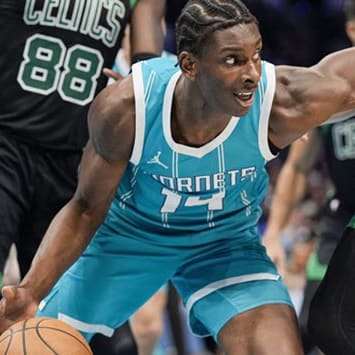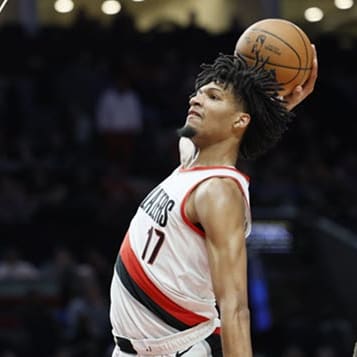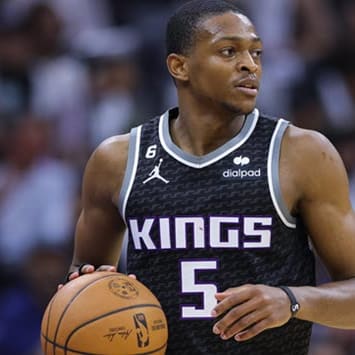This article is part of our NBA Team Previews series.
INDIANA PACERS
By Jeff Erickson
RotoWire Senior Editor
STATE OF THE FRANCHISE
"The Change We Need." Residents of Indiana will hear that refrain often this October, but not just in relation to the presidential race. They'll also hear it from the Pacers, who have finally begun rebuilding in earnest. After coming to grips with the reality that the current core could only lead them to mediocrity, they traded cornerstone player Jermaine O'Neal to the Raptors and made Jamaal Tinsley a redundant part by acquiring T.J. Ford and Jarrett Jack. Tinsley will eventually be an ex-Pacer – it's just a matter of finding the right trading partner.
The end result will leave the Pacers with some immediate pain, but at the end of the day, that pain is a necessary evil. They're not going to be a team that lands marquee free agents, and continually selecting in the middle-to-late spots in the first round of the NBA Draft prevented their chances of improving significantly there on a regular basis, the fall-in-the-lap selection of Danny Granger two years ago notwithstanding. This is going to be a team that will score its share of points in Jim O'Brien's up-tempo system, but it will also give up a ton. They have one big contract off the books in O'Neal, but cap space isn't everything. They'll need to draft and develop well over the next few years to return to perennial playoff contender status.
PLAYING TIME DISTRIBUTION
Three players are guaranteed extensive playing time – Danny Granger, Mike Dunleavy Jr. and Troy Murphy. Dunleavy and Granger will occupy the shooting guard and small forward spots, respectively, while Murphy will play most of his minutes at power forward, occasionally sliding over to play center. Granger will log nearly 40 minutes, Dunleavy 35 minutes, and Murphy closer to 30 minutes. Following the three constants in the lineup, there are two job battles that won't likely be settled by the end of training camp.
The first battle is at point guard, where Jamaal Tinsley is so far out of the Pacers' plans that they've removed the nameplate from his locker, even though he's still officially on the team. The team struggled to find a legitimate replacement for him during his typical injury spells, and when he was healthy he was still too much of a shoot-first, pass-second point guard. The Pacers addressed this shortcoming by trading for not one, but two point guards this summer. T.J. Ford came over from the Raptors as the primary acquisition in the O'Neal trade, and has the inside track on starting. But the Pacers also traded for Jarrett Jack from Portland on draft day, and he's also slated to play "significant minutes" – in fact, coach O'Brien suggested that Jack could play some at the shooting guard slot. Expect both to average around 25-30 minutes per game.
The other training camp battle occurs at center, where the job will be split among Jeff Foster, Radoslav Nesterovic and rookie Roy Hibbert. Early on expect Foster to play more often to help shore up the Pacers' defense, which lacked an inside presence. Hibbert could play more often as he develops, but we get the idea that we'll see a lot of "DNP-CD's" next to his name in the boxscore early on. Look for a 25-15-5 split between Foster, Nesteroviic and Hibbert.
The remaining minutes will go mostly to Marquis Daniels, who can play multiple positions ranging from point guard to small forward, Shawne Williams and rookie shooting guard Brandon Rush. Daniels, when healthy, could play up to 20 minutes per game.
PLAYER OUTLOOKS
Center:
Jeff Foster: From a fantasy perspective, Foster does just one thing that can help you – rebound. He's not going to score, block shots, get steals or shoot threes, and his good field-goal percentage doesn't help you because he doesn't shoot frequently enough. Factor in his chronic back problems, and Foster makes a poor fantasy investment.
Roy Hibbert: Hibbert is a traditional back-to-basket center offensively, and a superb shot-blocker on the other end. But he stagnated a bit between his junior and senior seasons at Georgetown, in particular failing to develop that much offensively. There's a risk that he won't be athletic enough to handle opposing big men in the NBA and could be raw in his rookie season. Don't be surprised if he's chained to the bench early on.
Radoslav Nesterovic: Nesterovic doesn't seem like an ideal fit for coach Jim O'Brien's fast-paced offense. He's not especially mobile, and he doesn't have an outside shot. When the Raptors faced a mobile team like Orlando in the playoffs, Nesterovic's playing time dwindled almost completely. He'll have his moments offensively, much as he did late in the regular season last year, but if/when Hibbert earns O'Brien's confidence, it will likely come at the expense of Nesterovic.
Forward:
Danny Granger: Granger broke out in 2007-08 for career-highs in seven of the eight standard roto categories, including 19.6 points, 6.1 boards, and 2.3 combined steals/blocks per game. Granger is a large small forward at 6-9 and almost 230 pounds, and he uses that size to his advantage with a nice mid-range-and-in game on offense. He's able to post up smaller wings, and he's comfortable facing up and knocking in jumpers over slower defenders. But what really took his game to the next level was a mastery of the 3-point shot, as he knocked down 2.1 per game last year. Now that Jermaine O'Neal has been traded out of Indiana, the Pacers are Granger's team to lead on both offense and defense. And with a pure point guard like T.J. Ford added to the mix, the entire Pacers offense should run more smoothly, which should lead to more and higher-percentage shots for Granger.
Troy Murphy: The Pacers have no shortage of bodies that can play the five, but none offer the offensive potential of Murphy. He may not line up at center often this season, but his 26 starts in 2007-08 qualify him in most formats. Besides, he'll operate on the low block whenever the team goes small and quick, which should be often. There's no doubt where Indiana's strengths lay. This team will live and die with its guards and perimeter scorers. Although Murphy's a good rebounder, he'll play more away from the basket, where he has good range out to the three-point line (39.8 percent last year). The Pacers added Rasho Nesterovic, who should get a lot of minutes at center, and return uber-rebounder Jeff Foster, so Murphy's rebounding skills will not be needed as much as his scoring ones.
Shawne Williams: Williams' repeated off-the-court incidents hide his development through the first two seasons of his NBA career. He's still pretty raw, but he improved across the board everywhere but in his shooting percentages. The Pacers have put him on double-secret probation for all the issues he's run into off the court, but they're far more likely to keep Williams than run him out of town as they are doing with Tinsley.
Maceo Baston: Baston was a throw-in coming back to the Pacers in the Jermaine O'Neal deal. His 2006 season with the Pacers was his most successful as an NBA player, but even then, he averaged just short of nine minutes per game. He'll be lucky to play that often this season.
Josh McRoberts: Another throw-in during the Pacers' offseason overhaul, McRoberts played in only eight games last year with the Blazers. He's capable of providing some defensive help in the interior, but that's about his upside for now.
Guard:
Mike Dunleavy Jr.: Dunleavy set career-highs in every major category last year, emerging as one of the better second-tier wings in the NBA. Pacers head coach Jim O'Brien's offense-heavy system makes Dunleavy's size (6-9, 230) and ball-handling ability a mismatch for opposing shooting guards, and since the Pacers don't play much defense (105.4 ppg allowed) Dunleavy's lack of foot speed on that end of the court doesn't prevent him from getting big minutes (career-high 36 mpg). With T.J. Ford now on the team, Dunleavy won't have to initiate the Pacers' offense as much this season, but he should also benefit from a more efficient all around offense that gets him better shots.
T.J. Ford: Injuries are an unavoidable factor in any sporting situation – but T.J. Ford's medical history is one of the scariest you're likely to encounter, and that will always cast a pall on his remarkable basketball ability. Ford suffers from a condition called spinal stenosis – a narrowing of the spinal column that compresses the spinal cord and associated nerves, and places Ford at risk of serious injury every time he takes a shot to the head or neck – he missed the entire 2004-05 season due to a spinal contusion. When healthy, Ford is an electric player – one of the quickest in the NBA – who should be primed for a career year playing in Jim O'Brien's up-tempo offense and freed from the job-share with Jose Calderon that hurt his value in Toronto. But if you do draft him, be sure to have a capable backup on hand. With his injury history and slight build, it seems unwise to expect more than 50-60 games out of Ford in any given season.
Marquis Daniels: Daniels' playing time varied wildly under coach Jim O'Brien, in part due to nagging ankle and hamstring injuries, but also because he fell in and out favor with O'Brien. Daniels can play multiple positions ranging from point guard to small forward when the Pacers go small. The variance in playing time is a problem, though. Barring injuries, it's hard to envision him playing more than 20 minutes per game on a regular basis.
Jarrett Jack: The Pacers acquired Jack from Portland in a Draft Day trade that also included Ike Diogu and a swap of first-round picks Brandon Rush and Jerryd Bayless. He'll compete with T.J. Ford for the starting point-guard job, though coach Jim O'Brien has suggested that Jack will also see some time at shooting guard. Jack is a little bigger than Ford and a better outside shooter, though Ford is quicker and tends to end up with more assists and steals. Both might sit occasionally when O'Brien decides to go big and installs Marquis Daniels at the point.
Travis Diener: Diener is a classic "tweener" – too slow to handle the point guard position on a full-time basis, and too small (6-1, 165) to defend most NBA shooting guards. Because of the Jamaal Tinsley's injuries and the Pacers' lack of depth at the point, Diener was overexposed, playing 20.5 minutes per game. Following the acquisitions of T.J. Ford and Jarrett Jack, Diener is down to third on the depth chart and will play far less frequently. He also had surgery on his left foot in May and has been slow to heal. The one thing he'll offer from a roto capacity is a good three-point shot, but with a lack of regular playing time, it'll be pretty difficult to justify a spot on your active roster to chase those threes.
Brandon Rush: The Pacers are stockpiling shooters to help mold to coach Jim O'Brien's fast-paced system. Rush is just that, and he's a pretty good defender to boot. One thing he'll need to improve is his assertiveness – often at Kansas he'd get lost in the flow and not demand his shot. In O'Brien's system, passing up shooting opportunities is a cardinal sin. Rush will often be used when the Pacers go small, playing at the same time as Danny Granger and Mike Dunleavy. One quick injury note – Rush hurt his knee in April 2007; otherwise he would have gone in the 2007 draft.
Jamaal Tinsley: Tinsley is persona non grata with the Pacers, so much so that they've already removed the nameplate from his locker even while he's still on the team. The oft-injured point guard had played in more than 52 games just once in the last five seasons, bottoming out last year with a knee injury that limited him to 39 games. The problems don't stop there - he's run into frequent trouble off the court as well. When he does play, he's the very definition of variance – capable of producing a triple-double or going 1-for-10 from the field with two assists. The problem is that he often falls in love with calling his own number, especially when he starts firing away from outside.
Stephen Graham: At this point, Graham is the last guy off the bench for the Pacers. He was used in only 23 games last season, and averaged less than six minutes per game when he did play. Expect more of the same this season.
Sleeper:
T.J. Ford: Ford is an ideal fit in coach Jim O'Brien's system – particularly in category-style league, where assists are at a premium. Because of his health issues in the past, he's going to come at a discount. He should beat out Jarrett Jack for the starting job in training camp this fall.
Bust:
Roy Hibbert: The Pacers have an opening at center, and Hibbert only has Jeff Foster and Rasho Nesterovic to beat, but Hibbert's offensive game stagnated so badly in his senior year at Georgetown that it's hard to envision him earning much playing time early on. He'll probably provide some rebounding and blocked shots, but in limited time.
Article first appeared on 9/25/08












